|
Jumping your way to a more fit body could be just the workout for you. Rosanna and Greg of MY FOX 5 New York hopped onto a trampoline for an unconventional exercise lead by Trainer Montserrat Markou, owner of Jumplife in Tribeca. Rosanna cannot seem to stop eating her chocolate cake. Check out the funny Video.
0 Comments
The truth behind the Urban Rebounding trend that has celebrities singing its' praise and is now incorporating trampolines into many cardio workout classes throughout the country.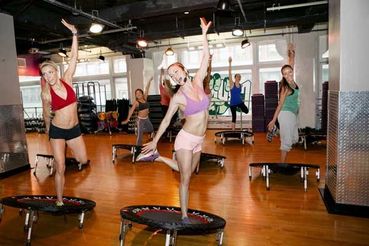 Urban Rebounding Class is the hottest cardio workout trend Urban Rebounding Class is the hottest cardio workout trend 1. Get a natural face lift. As we age, oxygen levels in the skin cells decrease, resulting in a loss of elasticity and the formation of lines and wrinkles. Rebounding circulates more oxygen to tissue and increases elasticity. 2. Develop the lean muscles and balance of a ballet dancer. Rebounding encompasses gravity, acceleration, and deceleration into your workout, which elongates your muscles as if you were a ballet dancer. 3. Your back and knees will thank you. It’s a low-impact cardio exercise that absorbs 80% of the shock. As a result it helps strengthen your back muscles and takes the pressure off of your spine and knees, without the strain and trauma of a hard surface workout. 4. Work out like a NASA astronaut. A NASA study found that rebounding is 68% more efficient than running or jogging. And rebounding proved to be the best exercise to rebuild the lost bone tissue of astronauts whose weightless state caused them to lose 15% of their bone mass. So rebounding can help prevent osteoporosis and reverse damage. 5. Say adios to colds and allergies. Rebounding cleanses your lymphatic system and boosts your immunity. The result? Colds and allergy symptoms won’t bother you as often or as much. Erica Bigler, an occupational therapist at the Lakeside Center for Autism, said students who use the trampoline show increased muscle and bone strength and cardio endurance. "They have improved balance and kinesthetic awareness".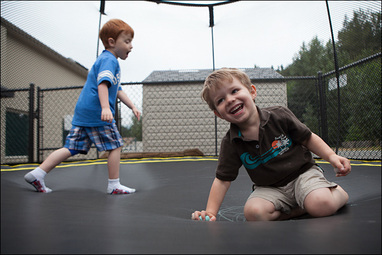 Trampolines helping kids with Autism reach new heights Trampolines helping kids with Autism reach new heights Newton Miller, 7, has a peculiar habit when he’s feeling anxious or bored: he squats on the floor and leaps into the air like a frog. The activity can be hazardous when he jumps off the bay window in his living room or while running errands with his mother. He once crashed into a shopper while he was “frogging” at the grocery store. Newton’s mother Deirdre believes her son’s desire to jump is a consequence of his autism. And, she’s found an appropriate place for him to jump as much as he wants without hurting himself or others: a trampoline. Autism spectrum disorder is a range of complex neurodevelopment disorders characterized by social impairments, communication difficulties and restricted, repetitive and stereotyped patterns of behavior. The Lakeside Center for Autism in Issaquah uses a trampoline, donated by Springfree Trampoline, to help children with autism. The trampoline is used for speech, occupational, physical and behavioral therapies. Erica Bigler, an occupational therapist at Lakeside, said students who use the trampoline show increased muscle and bone strength and cardio endurance. They have improved balance and kinesthetic awareness. Bigler works with a 5-year-old boy who came to the center with poor core strength. He would trip and fall often during therapy sessions until he started jumping on the trampoline. “You can see quite a difference in how he can control his body more effectively,” Bigler said. The same student had poor social skills, like many other children with autism. But, Bigler said when kids jump together on a trampoline they share an enjoyable activity and develop increased body awareness around their peers. “He typically prefers isolated play, but when he’s on the trampoline he’s having such a good time,” Bigler said. “It’s one of the only places I see him interact with a peer and sustain attention on a game.” Speech therapists at Lakeside use the trampoline as a motivational tool, allowing children to play on the trampoline if they speak or repeat a word. “He’ll do amazing things for the trampoline,” Deirdre said of Newton. Teachers also use the trampoline to teach students how to follow directions by playing games, such as “Simon Says.” Children with autism tend to learn more effectively when they are able to reinforce their intellectual development with physical movements, so staff members at Lakeside often write words on the trampoline with chalk and ask students to jump from one word to another to form a sentence. “It’s amazing what kids on that spectrum can do on a trampoline that they might not have been able to without that sensory input,” Bigler said. “You see kids going from disengaged and non-communicative to making eye contact and being more aware of what’s going on.” While Deirdre said Newton is often under-stimulated, the trampoline offers him an outlet to expel his energy and has improved his concentration. “When he’s [frogging] at Lakeside they can move it to an appropriate environment,” she said. “We’re not denying it to him but giving him an appropriate framework.” But, kids at the Lakeside Center for Autism are not the only ones reporting life-changing results; adults living with autism in the community are also benefitting from trampolines. Anabelle Listic, a 28-year-old Seattle woman with autism has two trampolines at home and uses them daily to process information and cope with anxiety. “My moments of true clarity always happen when I’m on my trampoline,” Listic said. “It’s like meditation to me.” When Listic temporarily moved to Oregon years ago, she brought a trampoline with her instead of a bed. “I don’t ever want to have to live without jumping on a trampoline,” she said. “When I’m on a trampoline everything feels effortless and makes sense and feels okay.” Listic even took her trampoline on a light rail train once. A friend had invited her to the opening of his art exhibit but Listic was feeling anxious about the event. So, she brought a 48-inch trampoline on the light rail and into the gallery. “I was either going to bring it with me or not go,” Listic said. “It was incredibly helpful.” She said just sitting or lying on a trampoline can help people with autism. “Sometimes I just lie on my trampoline and pound my fists on it. I’m moving that muscle and it’s self-regulating and soothing. That tiny bit of rebounding feels safe and comfortable to me.” Source: Komo News Written By: Rose Egge You can watch Listic on her trampoline in this video she made for others with autism: Indoor Trampoline Parks are popping up everywhere and with them a healthy exercise trend that combines Trampolines and Aerobics exercises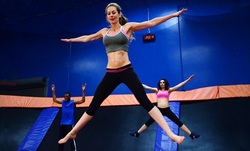 Most people jump on a trampoline for fun. However, many doctors, coaches, trampoline experts, and even NASA astronauts, agree that trampoline exercise provides the most time and energy-efficient workout possible. Calories burn more efficiently during trampoline exercise, and there is less stress on the body than with jogging, or jumping rope. Sky Zone is the creator of the world's first all trampoline, walled playing court. One of their premier classes, SkyRobics, is a 60-minute trampoline fitness class that combines core exercises, advanced calisthenics and strength building aerobics. Some activities performed in SkyRobics include laps the length of the trampoline, jumping jacks, skiing, squats, high knees and circuit training. Things are looking up: expect to burn 1,000 calories while doing it! But, you can actually achieve the same results by performing aerobics exercises on your home or backyard trampoline. This can be done by watching a workout video or by hiring a personal trainer. Take a look at some of the Trampoline Options that we offer. 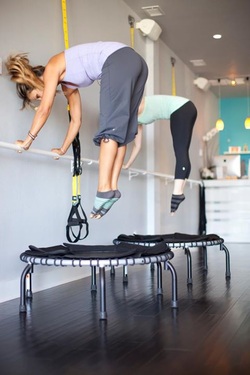 TRAMPilates is the hottest new workout that combines Pilates with Trampolines. This new version of Pilates has spread due to the popularity of Indoor Trampoline Parks that are popping up everywhere around the US. The following is a brief explanation of TRAMPilates by Fitness Movement Pilates Studio of Westlake Village, CA. "TRAMPilates – Our trainers have created a class format that alternates between the Trampoline and the Pilates Plus Machine (Megaformer) for a circuit training type of workout. In one 55 minute class you will boost your energy, tone, and strengthen muscle (especially your core), increase your metabolism and burn lots of calories! It is easy to follow and low-impact exercises are done interval style to get the maximum calorie burn in the shortest time. The lymphatic system benefits from this type of exercise-a boost in the lymphatic system increases the amount of waste and toxins flushed from the body. Fitness Trampolining can increase the lymph flow by up to 15%! Because of the “bouncing” this form of exercise improves your brains responsiveness within the inner ear and improves balance. This mini-trampoline provides an extremely effective LOW-IMPACT workout which is especially important for those with less mobility, or injury rehabilitation. For those clients who have run previously but no longer can run due to joint pain caused by the constant impact or shin splints, try running on the trampoline!! You can get all the G-force without the impact. Its gentle on your joints and most importantly it’s FUN!" Fitness Movement 1145 Lindero Canyon Road, #C-01 Westlake Village, CA 91362 Phone 818-874-9006 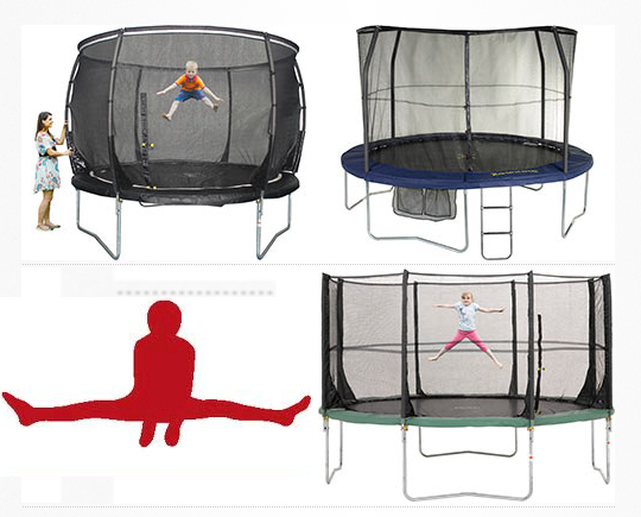 Studies by NASA scientists show that rebounding is 68% more effective than jogging, and yet requires less effort! You can also develop both upper and lower body strength just as effectively as weight lifting–without the strain or threat of pulled or torn muscles. Rebounding has been shown to outperform swimming as an all round exercise. Apart from being great fun, bouncing on a trampoline brings a number of very real health and wellbeing benefits including:
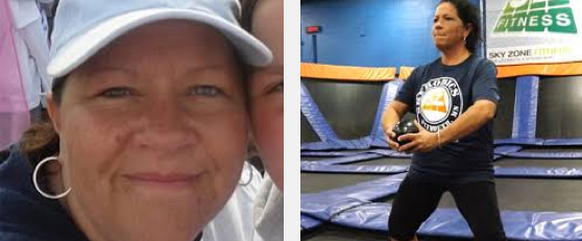 Before: 245
After: 132 Height: 5' 0" Age: 43 In 2007, Jodi Adkisson quit her job as an event coordinator to become a caretaker for her husband, Mike, who’d been injured in a work-related accident. Along with her career, she put her own health on the backburner. "I fell into the trap of not taking any time for me," Jodi remembers. "I just didn't eat. My metabolism just stopped." Less than three years later, Mike passed away, and Jodi faced financial setbacks and the challenge of providing for her two daughters. Lost in the needs of others, Jodi knew she was heavy, but wasn’t in tune to how the excess pounds made her look or feel. The Turning Point A year after her husband’s passing, in May 2012, Jodi's father was diagnosed with leukemia. By this point, she had ballooned to 245 pounds from 150. "When my dad got sick, I knew I didn’t want to be in that place anymore," Jodi says. "It sparked something inside my head." The Lifestyle A couple of Jodi’s friends invited her to try Skyrobics — a trampoline-based group exercise class that incorporates cardio, circuit training, core exercises, strength training, and calisthenics. Soon, she was hooked. Six times a week, she’d drive 40 minutes to Sky Zone Indoor Trampoline Park in Plymouth, MN. "Skyrobics would kick my butt, but it was more than just a workout for me—it was a mental escape," Jodi says. She didn’t just change her exercise habits. Jodi also stopped drinking soda, reduced her coffee consumption, traded high-fat dressings for lemon juice and salsa, substituted grilled chicken for breaded chicken and red meats, and cut out deep-fried foods in favor of healthier, baked ones. The secret to sticking to her diet was altering what she ate in ways she knew she could commit to long-term. "I don't believe in a diet; I believe in learning a new lifestyle," Jodi says. By June 2012, she had slimmed down to 132 pounds, a weight she has maintained by attending Skyrobics classes three times a week and continuing to eat healthily. The Motivation Today Jodi makes her well-being a priority, because it allows her to truly enjoy life. "That's what keeps me motivated,” she says. “If I don't take time for me, I will be unhappy, and I will be unhealthy.” The Reward "I'm definitely happier. It's put life into perspective for me," she says. Today, Jodi’s in a new relationship. "I never thought I'd have that again," she says. She also finds fulfillment in being able to model a healthy lifestyle for her children and inspiring others who want to make the same changes. Jodi's Advice Focus on yourself. "Taking care of yourself is probably the most important thing you can do. Take 15 minutes a day. Just say, 'You know what? I got this.' Even if you don't think you do," Jodi says. Have a treat. "Don't tell yourself you can't have a doughnut. Have a doughnut! Then work it off,” she says. “I don't believe in diets. A diet is not forever. You have to live with what you're doing." Source: http://fitbie.msn.com Author: Jessica Chia |
Trampolines Los Angeles
A blog about all things related to trampolines Archives
December 2019
Categories
All
|
| Trampolines Los Angeles |
|
 RSS Feed
RSS Feed
